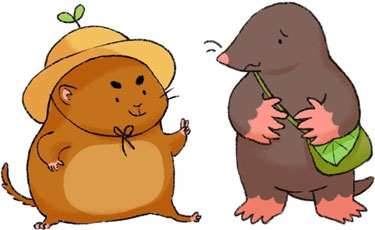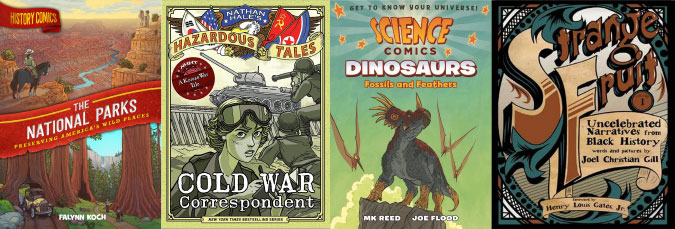Nonfiction Graphic Novels Spotlight Microhistories and Overlooked Historical Figures
Creators hone in on previously untold stories and lesser-known figures. Plus: 12 recommended titles.
 |
Expedition BackyardCourtesy of Random House Graphic |
There’s a thrill in learning about passed-over historyor underexamined phenomena. Lately, graphic novels have been diving deep into areas of history and science that are little known or have been absent from the historical record. The result is books that are sometimes serious, sometimes quirky, but always compelling for young readers. Consider Andy Warner’s Brief Histories of Everyday Objects (Picador, 2016), which does just what the title says: In short comics, Warner dredges up fascinating facts about such unremarkable items as kitty litter, Velcro, and safety pins. The book was intended for a general audience, but it was most successful with middle school and young adult readers, so that’s where Warner has turned his focus. He is currently working on a trilogy about animals, plants, and minerals; the first volume, Andy Warner’s Oddball Histories: Pests and Pets, will be published by Little, Brown this month.
Other untold stories focus on important overlooked histories. Joel Christian Gill’s “Strange Fruit” and “Tales of the Talented Tenth” series bring the deeds of Black achievers to the attention of middle school readers. Like many creators, Gill includes a bibliography so readers can learn more if their curiosity is piqued.
These graphic works pull in readers with a good yarn or a fun fact—and then go beyond the standard narratives, providing dimension to the broader subjects of history and science, while encouraging critical thinking. Add compelling illustrations, and these stories about the accomplishments of ordinary people, the history behind everyday things, or the glory that might be lurking in one’s own backyard couldn’t be more exciting.
In Expedition Backyard (Random House Graphic, forthcoming in 2022), writer Rosemary Mosco and illustrator Binglin Hu invite readers to explore the wonders of the world around them—through the eyes of a mole and a vole. The creatures accidentally move from the forest to the city and learn about their new surroundings, from lichen to warblers to a cat on a leash, which the vole mistakes for a lion. “I think it’s important to feel like nature is close to you and not a really faraway place you go to,” says Mosco. “There is so much you can learn about history and society from urban nature.”

Mosco, coauthor of The Atlas Obscura Explorer’s Guide for the World’s Most Adventurous Kid (Workman, 2018), has also led urban nature walks. “I want people to experience this kind of thing and feel like nature is an immediate thing we can all experience, not this faraway concept,” she says. Mosco describes, for instance, the dramatic vision of chimney swifts stopping over a chimney in her city: “They are like cigars with wings, and a thousand of them will do this incredible vortex and go backwards down the chimney.”
In The Bug Club (Drawn & Quarterly, 2021), Elise Gravel presents a menagerie of unusual critters—scorpion flies, pill bugs, praying mantises—with her trademark infectious enthusiasm, showing readers what the inside of a snail looks like and introducing them to tarantulas that keep frogs as pets. Along the way, she includes solid information about insect anatomy and invites readers to do their own research and exploration.
 |
Andy Warner’s Brief Histories of Everyday Objects reveals intriguing backstories behind mundane items. This microhistory of the toothbrush is one of a few items from a section titled “The Bathroom.”© 2016 by Andy Warner. Reprinted by permission of Picador. |
Spotlighting lesser-known figures
A strong, welcome trend in graphic novels is telling the stories of fascinating but historically neglected people and happenings. “Honestly, if it were up to me, all the books in the History Comics series would be about lesser-known people and events,” says Dave Roman, a freelance series editor at First Second. He cites their book History Comics: Rosa Parks and Claudette Colvin: Civil Rights Heroes (forthcoming in 2023) as an example; while most people are familiar with Parks, fewer know about Colvin, whose refusal to yield her seat on a bus led directly to the Montgomery bus boycott. Colvin’s case was dropped by civil rights groups after she became pregnant while still a teen, but it got the movement started. Her experience makes fascinating reading—and offers new insights into the civil rights movement.
Gill’s recent graphic novel Robert Smalls: Tales of the Talented Tenth (Chicago Review/Fulcrum, 2021) depicts the daring feats of an enslaved man who, in 1862, hijacked a Confederate ship to bring himself and his family to freedom. Gill’s story is filled with details about Smalls and the world he lived in, and in the framing tale and the afterword, he invites young readers to think about Reconstruction, a time when the possibilities for African Americans seemed limitless.
The U.S. government’s internment of Japanese Americans during World War II was not taught in schools until recently, but now it’s familiar enough that there are several excellent graphic novels about it, including George Takei’s (Top Shelf, 2019). There are many more stories to be told. In We Hereby Refuse: Japanese American Resistance to Wartime Incarceration (Chin Music Press, 2021), writers Frank Abe and Tamiko Nimura and artists Ross Ishikawa and Matt Sasaki tell the stories of three Japanese Americans who stood up for their rights: One refused to be drafted, one refused to sign a loyalty oath, and one sued the government, choosing to stay in the internment camp as her case made it all the way to the Supreme Court. Their stories illuminate the diversity of attitudes within the Japanese American community, not only those of the three who are profiled, but also those of others who counseled acquiescence rather than resistance.
For some graphic creators, focusing on a lesser-known single person is simply the best way to tell the story while illuminating a larger historical event. In Nathan Hale’s Hazardous Tales: Cold War Correspondent (Abrams, Oct. 2021), Hale tells the story of the Korean War through the eyes of Maggie Higgins, one of the few female war correspondents of the time, who was in Seoul when the Communists invaded the city. Hale says he chose her as the point-of-view character because her story was so captivating. “When I look for people or periods to make comics about, I’m looking for thrills,” he says. “Higgins’s adventures covering the Korean War were exciting, visual, [and] funny.” After witnessing the bombing of a bridge, Higgins was trapped on the wrong bank and crossed the river by raft. When she arrived at U.S. military headquarters the next day, an Army general ordered her out of the country, saying women journalists were too much trouble. She went over his head to General Douglas MacArthur, who allowed her to stay.

History in a bowl of ice cream
Microhistories offer a wealth of information behind topics not usually given the historical treatment. In the introduction to Brief Histories of Everyday Objects, Warner points out that people cleaned their teeth with soot and rags until William Addis, thrown in jail in 1770 for inciting a riot, distracted himself by inventing the toothbrush. He created the first one by drilling holes in a bone left over from his dinner and inserting animal bristles into the holes.
In History Comics: The Wild Mustang, Chris Duffy and Falynn Koch depict the importance of horses to the different cultures of the American West—the Pueblo, the Comanche, the Spanish—and the role that played in the region’s history. And in Yummy (Random House Graphic, Oct. 2021), Victoria Grace Elliot uses a trio of cute food sprites to trace the lineage of a variety of sweets through geography and time, with side anecdotes about people and science.
Yummy also includes “the ugly side of history”: imperialism and unbridled capitalism. “Sugar is not European,” says Elliot. “The same with cocoa, the same with vanilla. How did it get there? The answer is not necessarily pretty.”
“I can only go so intense with it because I’m dealing with it in the framework of 8 to 12 years old,” she adds. “But it’s important for kids to learn this information.” For instance, Emperor Nero’s frozen desserts were based on ice brought from the mountains by enslaved people; mooncakes were used to hide coded messages when the Han Chinese revolted against Mongolian invaders; and the Japanese cake known as Castella has its roots in durable sponge cakes that arrived in Japan with Portuguese traders in the 1700s. Like Warner’s toothbrush, the desserts’ backstories show us more about the world they came from.
With strong visuals and inquisitive approaches, these nonfiction works often encourage critical thinking. In History Comics: The National Parks (First Second, forthcoming in Apr. 2022), author Falynn Koch depicts what nature enthusiasts love about the parks—and an aspect of their history that has been seldom addressed until recently: “how the U.S. government removed the original tribal nations that once inhabited them,” says Roman. “We think it’s better to address the uncomfortable truths rather than sweep them under the rug.”
“Views surrounding conservation and public lands have changed over the decades,” says Roman. “Falynn [used] the comics medium to represent these changing ideals through morphing cartoon eagles that split off and argue with themselves. And the book is hosted by Bigfoot just to keep all political stuff from getting too dry.”
“So much of the history my generation grew up with is more akin to tall tales and Disney-fied versions of fables,” says Roman. “We’ve pushed the ‘History Comics’ authors to dig deeper and get as authentic as possible.”
“We don’t want to read a book that treats the founding fathers of America like the gods of Olympus,” he adds. “We’d rather get to know them as people, flaws and all. Maybe inspire a reader to realize that their choices matter and they too can affect the arc of history.”
Fascinating Facts & Histories

We Hereby Refuse: Japanese American Resistance to Wartime Incarceration by Frank Abe, Tamiko Nimura, Ross Ishikawa, and Matt Sasaki. Chin Music Press. May 2021.
Gr 8 Up–Three interwoven stories in two different styles tell of three Japanese Americans who resisted their imprisonment and classification as enemy aliens.
History Comics: The Wild Mustang by Chris Duffy and Falynn Koch. First Second. Feb. 2021.
Gr 4-6–Duffy and Koch trace the history of
horses in America, focusing on how the interactions between humans and horses shaped history.
Yummy by Victoria Grace Elliot. Random House Graphic. Oct. 2021.
Gr 3-7–A trio of food sprites take readers on a culinary tour of history, looking at the origins and evolution of ice cream, cakes, brownies, and more. Elliot spices up the narrative with story times, science experiments, and recipes.
The Bug Club by Elise Gravel. Drawn & Quarterly. Aug. 2021.
Gr 1-2–Gravel introduces readers to some of the odder invertebrates, including spiders, insects, and the tardigrade, with simple drawings and plenty of humor.
“Strange Fruit” by Joel Christian Gill. Chicago Review/Fulcrum. 2014-18.
Gr 7 Up–These two anthologies collect short narratives about Black achievers and their central role in American history.
Robert Smalls: Tales of the Talented Tenth by Joel Christian Gill. Chicago Review/Fulcrum. May 2021.
Gr 7 Up–Gill’s “Tales of the Talented Tenth” series features longer biographies of Black people throughout history. This one tells the story of Robert Smalls, an enslaved man who took command of a Confederate ship to bring himself and his family to freedom.
Nathan Hale’s Hazardous Tales: Cold War Correspondent by Nathan Hale. Abrams. Oct. 2021.
Gr 3-7–Hale tells the story of the Korean War through the eyes of correspondent Maggie Higgins, who witnessed many of the events and had to appeal to General Douglas MacArthur himself after the Army ordered her away from the front lines.
History Comics: The National Parks by Falynn Koch. First Second. Apr. 2022.
Gr 4-8– Koch looks at the creation of the National Park System through the eyes of both conservationists and the Indigenous people who lived on the land before it was seized to create the parks.
Expedition Backyard by Rosemary Mosco and Binglin Hu. Random House Graphic. Summer 2022.
Gr 2 Up–Mosco, a nature writer, and Hu, an illustrator for the National Aquarium, help readers see the fascinating plants and animals all around them.
Science Comics: Dinosaurs by MK Reed and Joe Flood. First Second. 2016.
Gr 4-6–Reed and Flood present not just the science of dinosaurs but the history of that science, showing how the “facts” about dinosaurs changed over the years and how the feuds and one-upmanship of individual scientists shaped the field of paleontology.
Andy Warner’s Oddball Histories: Pests and Pets by Andy Warner. Little, Brown. Sept 2021.
Gr 3-7–In the first of three volumes, Warner presents brief histories of a variety of animals, with a focus on the unexpected.
Brief Histories of Everyday Objects by Andy Warner. Picador. 2016.
Gr 7 Up–Warner picks up interesting bits of history and packages them in three- or four-page comics, each followed by a few bonus “fun facts.”

RELATED
The job outlook in 2030: Librarians will be in demand
The job outlook in 2030: Librarians will be in demand
ALREADY A SUBSCRIBER? LOG IN
We are currently offering this content for free. Sign up now to activate your personal profile, where you can save articles for future viewing





Add Comment :-
Be the first reader to comment.
Comment Policy:
Comment should not be empty !!!